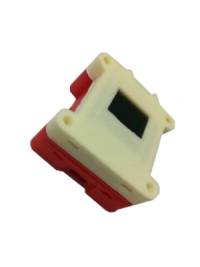Oled ekraani näidis
Oled moodul peab olema ühendatud kontrolleri või anduri mooduliga.
Vajaminevad teegid:
lib_deps = ITTIoT, Adafruit GFX Library, Adafruit SSD1306 Wemos Mini OLED, adafruit/Adafruit BusIO
Näidiskood näitab loenduri väärtust ekraanil:
#include <Arduino.h> #include <ittiot.h> #include <Ticker.h> #include <ESP8266WiFi.h> #include <Adafruit_I2CDevice.h> #include <Adafruit_GFX.h> #include <Adafruit_SSD1306.h> #define WIFI_NAME "name" #define WIFI_PASSWORD "password" // OLED reset pin is GPIO0 #define OLED_RESET 0 // GPIO0 Ticker timeTicker; Adafruit_SSD1306 display(OLED_RESET); // Create an object for OLED screen bool isBootModeNormal; bool sendDataFlag; int i = 0; // Counter variable is defined // ITT splashs screen bitmap. Generator can be found in: http://javl.github.io/image2cpp/ static const unsigned char PROGMEM logo16_glcd_bmp[] = { 0x00, 0x00, 0x00, 0x00, 0x00, 0x00, 0x00, 0x00, 0x00, 0x07, 0xf0, 0x00, 0x00, 0x00, 0x00, 0x00, 0x00, 0x07, 0x10, 0x00, 0x00, 0x00, 0x00, 0x00, 0x00, 0x07, 0x10, 0x00, 0x00, 0x00, 0x00, 0x00, 0x00, 0x07, 0x10, 0x00, 0x00, 0x00, 0x00, 0x00, 0x00, 0x07, 0x10, 0x00, 0x00, 0x00, 0x00, 0x00, 0x00, 0x07, 0x1f, 0xff, 0xff, 0xc0, 0x00, 0x00, 0x00, 0x07, 0x00, 0x00, 0x00, 0xc0, 0x00, 0x00, 0x00, 0x07, 0x00, 0x00, 0x00, 0xc0, 0x00, 0x00, 0x00, 0x07, 0x00, 0x00, 0x00, 0xc0, 0x00, 0x00, 0x00, 0x07, 0x1f, 0xe3, 0xff, 0xc0, 0x00, 0x00, 0x00, 0x07, 0x1f, 0xe3, 0xff, 0xc0, 0x00, 0x00, 0x00, 0x07, 0x10, 0xe2, 0x00, 0x00, 0x00, 0x00, 0x00, 0x07, 0x10, 0xe2, 0x00, 0x00, 0x00, 0x00, 0x00, 0x07, 0x10, 0xe2, 0x00, 0x00, 0x00, 0x00, 0x00, 0x07, 0x10, 0xe3, 0xff, 0xff, 0xf8, 0x00, 0x00, 0x07, 0x10, 0xe0, 0x00, 0x00, 0x18, 0x00, 0x00, 0x07, 0x10, 0xe0, 0x00, 0x00, 0x18, 0x00, 0x00, 0x07, 0x10, 0xe0, 0x00, 0x00, 0x18, 0x00, 0x00, 0x07, 0x10, 0xe3, 0xfc, 0xff, 0xf8, 0x00, 0x00, 0x07, 0x10, 0xe3, 0xfc, 0xff, 0xf8, 0x00, 0x00, 0x07, 0x10, 0xe2, 0x1c, 0x80, 0x00, 0x00, 0x00, 0x07, 0x10, 0xe2, 0x1c, 0x80, 0x00, 0x00, 0x00, 0x07, 0x10, 0xe2, 0x1c, 0x80, 0x00, 0x00, 0x00, 0x07, 0x10, 0xe2, 0x1c, 0x80, 0x00, 0x00, 0x00, 0x07, 0x10, 0xe2, 0x1c, 0x80, 0x00, 0x00, 0x00, 0x07, 0x10, 0xe2, 0x1c, 0x80, 0x00, 0x00, 0x00, 0x07, 0x10, 0xe2, 0x1c, 0x80, 0x00, 0x00, 0x00, 0x07, 0xf0, 0xe2, 0x1c, 0x80, 0x00, 0x00, 0x00, 0x00, 0x00, 0xe2, 0x1c, 0x80, 0x00, 0x00, 0x00, 0x00, 0x00, 0xe2, 0x1c, 0x80, 0x00, 0x00, 0x00, 0x00, 0x00, 0xe2, 0x1c, 0x80, 0x00, 0x00, 0x00, 0x00, 0x00, 0xe2, 0x1c, 0x80, 0x00, 0x00, 0x00, 0x00, 0x00, 0xe2, 0x1c, 0x80, 0x00, 0x00, 0x00, 0x00, 0x00, 0xe2, 0x1c, 0x80, 0x00, 0x00, 0x00, 0x00, 0x00, 0xe2, 0x1c, 0x80, 0x00, 0x00, 0x00, 0x00, 0x00, 0xe2, 0x1c, 0x80, 0x00, 0x00, 0x00, 0x00, 0x00, 0xfe, 0x1c, 0x80, 0x00, 0x00, 0x00, 0x00, 0x00, 0x00, 0x1c, 0x80, 0x00, 0x00, 0x00, 0x00, 0x00, 0x00, 0x1c, 0x80, 0x00, 0x00, 0x00, 0x00, 0x00, 0x00, 0x1c, 0x80, 0x00, 0x00, 0x00, 0x00, 0x00, 0x00, 0x1c, 0x80, 0x00, 0x00, 0x00, 0x00, 0x00, 0x00, 0x1c, 0x80, 0x00, 0x00, 0x00, 0x00, 0x00, 0x00, 0x1c, 0x80, 0x00, 0x00, 0x00, 0x00, 0x00, 0x00, 0x1c, 0x80, 0x00, 0x00, 0x00, 0x00, 0x00, 0x00, 0x1c, 0x80, 0x00, 0x00, 0x00, 0x00, 0x00, 0x00, 0x1f, 0x80, 0x00, 0x00, 0x00, 0x00, 0x00, 0x00, 0x00, 0x00, 0x00, 0x00 }; // Ticker library callback, which will occur 0.5 second interval. void sendData() { sendDataFlag=true; } // If message received print it out. void iot_received(String topic, String msg) { Serial.print("MSG FROM USER callback, topic: "); Serial.print(topic); Serial.print(" payload: "); Serial.println(msg); } // Function started after the connection to the server is established. void iot_connected() { Serial.println("MQTT connected callback"); iot.log("IoT OLED screen example!"); isBootModeNormal = true; } void setup() { Serial.begin(115200); // setting up serial connection parameter Serial.println("Booting"); // initialize with the I2C addr 0x3C (for the 64x48) display.begin(SSD1306_SWITCHCAPVCC, 0x3C); // Since the buffer is initialized with an Adafruit splashscreen // internally, we should clear it display.clearDisplay(); // Load ITT splash screen into buffer display.drawBitmap(0, 0, logo16_glcd_bmp, 64, 48, 1); // Show image buffer on the display display.display(); // Display splashscreen two second delay(2000); //iot.setConfig("wname", WIFI_NAME); //iot.setConfig("wpass", WIFI_PASSWORD); // print IoT json config to serial iot.printConfig(); // Initialize IoT library iot.setup(); // Initialize Ticker interval and callback timeTicker.attach(0.5, sendData); } // Main code, which runs in loop void loop() { // IoT behind the plan work, it should be periodically called iot.handle(); // Increase counter value by 1 i++; // Display counter value on the OLED screen display.clearDisplay(); // clears the srceen display.setTextSize(1); // sets the text size for the screen display.setTextColor(WHITE); // text color is set to white display.setCursor(0,0); // position from where the text writing is starting display.println("Counter: "); // a text is send to the screen display.println(i); // counter value is send to the screen display.display(); // show image // Send counter value to the computer if(WiFi.isConnected() && isBootModeNormal) { if(sendDataFlag) { sendDataFlag = false; String msg = String(i); iot.publishMsg("count", msg.c_str()); Serial.println(msg); } } delay(500); // delay of 0.5s, to change the counter value slowly }



